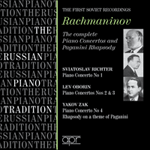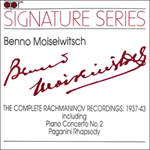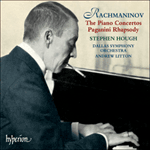
Welcome to Hyperion Records, a British classical label devoted to presenting high-quality recordings of music of all styles and from all periods from the twelfth century to the twenty-first.
Hyperion offers both CDs, and downloads in a number of formats. The site is also available in several languages.
Please use the dropdown buttons to set your preferred options, or use the checkbox to accept the defaults.

The theme itself comes from the last of Paganini’s Twenty-four Caprices Op 1 for solo violin. This unobtrusive yet wonderfully suggestive pattern of flicking upbeat motifs had already captured the imagination of Liszt and Brahms, and it would continue to inspire composers after Rachmaninov, as diverse as Witold Lutosławski and Andrew Lloyd Webber.
Rachmaninov’s first game is to place the theme—on the strings with the piano picking out salient notes—after the first variation. And that initial ‘variation’—on pizzicato strings following a general clearing of throats for orchestra and piano—is itself already something of a game, since it makes a pun with the finale of Beethoven’s Eroica Symphony (which likewise introduces a skeletal version before the theme itself). Now that the work is properly under way, Variations ii to vi start to split the elements of the theme apart and to recombine them into new musical personalities. The pauses and rhetorical flourishes for the piano in Variation vi herald a change of tempo and tone. Next the piano gravely intones the head-motif of the Dies irae—the medieval ‘Day of Wrath’ plainchant from the Mass for the Dead—while the orchestra accompanies with the opening motif of the Paganini theme. The Dies irae was a favourite of Rachmaninov’s, and its apocalyptic associations are by no means irrelevant even here. Still, the combination of ideas is a kind of musical game, and one that will be played out later in the Rhapsody.
But not immediately. In Variation viii the piano reinstates the fast opening tempo and leads off with determined staccato chords. This is another musical pun – an in-joke even. The motif is still Paganini’s, but the shape and gesture are taken straight from Glazunov’s Sixth Symphony, which the twenty-three-year-old Rachmaninov had arranged for two pianos. The piano and orchestra’s confrontational chords continue to accumulate, until the Dies irae bursts through again on the piano’s low octaves in Variation x. Another general pause ensues, and the piano’s scale and arpeggio flourishes in Variation xi herald a new slow phase. Variation xii is in the tempo of a minuet, with the Dies irae motif once again more to the fore than the Paganini theme.
Back in the main Allegro tempo, Variations xiii to xv form a kind of scherzo, the last of the three variations being initially for piano alone. Variations xvi and xvii become ever more shadowy, continuing the sequence of key-changes that began with No xiv and setting the stage for the famous Variation xviii. This glorious lyrical outpouring, based on an inversion of Paganini’s main motif (a sublime piece of game-playing this!), was already a legend in its composer’s lifetime, at least as early as 1939 when Fokine choreographed a ballet to the Rhapsody and—apparently with Rachmaninov’s collaboration—reintroduced the big tune as an apotheosis at the end of the work.
The last six variations make a dazzling finale, with piano, orchestra and composer going through increasingly virtuoso paces, and Rachmaninov’s last game-like gesture comes with the throwaway final cadence. In another sense, the very last of Rachmaninov’s games is actually the title he eventually settled on, having considered and rejected the perfectly appropriate ‘Symphonic Variations’ and the less happy ‘Fantasia’. For this Rhapsody is one of the most tautly constructed, least rhapsodic works he ever composed, and at the same time one of the most disciplined and inventive (not to mention thrilling and sensuously beautiful) sets of variations ever composed.
from notes by David Fanning © 2004
Le thème est tiré du dernier des Vingt-Quatre Caprices pour violon seul op. 1 de Paganini. Le motif discret et pourtant merveilleusement suggestif de motifs virevoltants et ascendants avait déjà captivé l’imagination de Liszt et de Brahms. Après Rachmaninov, il continuera à inspirer des compositeurs aussi différents que Witold Lutosławski et Andrew Lloyd Webber.
Le premier jeu de Rachmaninov est de placer le thème—aux cordes avec le piano reprenant les notes les plus marquantes—après la première variation. Et cette «variation» initiale—aux cordes en pizzicato suivies par l’orchestre et le piano qui s’éclaircissent la voix—est elle-même un jeu puisqu’elle se moque du finale de la Symphonie «Eroica» de Beethoven (don’t la version squelettique est pareillement introduite avant le thème proprement dit). L’œuvre étant bien avancée, les Variations ii à vi décomposent les éléments du thème pour les restructurer selon de nouvelles personnalités musicales. Les silences et les figurations rhétoriques du piano dans la Variation vi annoncent un changement de tempo et de climat. Le piano entonne ensuite le motif de tête du Dies irae—le plain-chant médiéval du Jugement dernier de la Messe des morts—tandis que l’orchestre l’accompagne avec le motif initial du thème de Paganini. Le Dies irae faisait partie des préférés de Rachmaninov. Ses connotations avec l’Apocalypse ne sont nullement déplacées dans cette œuvre. Pourtant, l’association d’idées est une sorte de jeu musical qui sera repris plus tard dans la Rhapsodie.
Pas immédiatement cependant. La Variation viii pour le piano réintroduit le tempo rapide du début et conduit à des accords staccato résolus. Voici une autre plaisanterie musicale—une plaisanterie pour les initiés même. Le motif est toujours celui de Paganini, mais les contours et les gestes sont directement tirés de la Symphonie no6 de Glazounov que Rachmaninov, alors âgé de 23 ans avant arrangée pour deux pianos. Les confrontations d’accords entre le piano et l’orchestre poursuivent leur accumulation jusqu’à ce que le Dies irae ne fasse de nouveau son entrée dans les octaves graves du piano, dans la Variation x. Un silence général règne ensuite. La gamme et les figurations arpégées du piano de la Variation xi annoncent une nouvelle section, lente. La Variation xii est dans le tempo d’un menuet, avec le motif du Dies irae de nouveau énoncé sur le thème de Paganini.
Renouant avec le tempo Allegro, les Variations xiii à xv forment une sorte de scherzo, la dernière des trois étant initialement conçue pour piano seul. Les Variations xvi et xvii s’assombrissent de plus en plus, avec les modulations constantes qui avaient débuté lors de la Variation xiv. Elles ouvrent la voie à la célèbre Variation xviii. Ce glorieux épanchement lyrique élaboré sur une inversion du motif principal de Paganini (un jeu absolument sublim!) tenait déjà de la légende du vivant du compositeur, du moins dès 1939 quand Fokine réalisa une chorégraphie sur la Rhapsodie—apparemment avec la collaboration de Rachmaninov—et réintroduisit l’ample mélodie en guise d’apothéose à la fin de l’œuvre.
Les six dernières variations constituent un finale époustouflant, avec le piano, l’orchestre et le compositeur voyageant à des allures de plus en plus virtuoses. Rachmaninov se prête à un dernier jeu avec la cadence finale désinvolte. Par bien des égards, c’est avec le titre que Rachmaninov joua une dernière fois, après avoir considéré et rejeté celui parfaitement approprié de «Variations symphoniques» et celui moins heureux de «Fantasia». Car cette Rhapsodie est une des œuvres les plus soigneusement construites, la moins rhapsodique qu’il ait jamais écrite, tout en étant aussi le recueil de variations le plus discipliné, le plus inventif (sans omettre la beauté saisissante et sensuelle) qui ait jamais existé.
extrait des notes rédigées par David Fanning © 2004
Français: Isabelle Battioni
Das Thema selbst stammt aus dem letzten der 24 Caprices op. 1 von Paganini für Solovioline. Das unaufdringliche und trotzdem suggestive Muster von schnippenden, auftaktigen Motiven hatte bereits die Phantasie von Liszt und Brahms angeregt und sollte auch Komponisten nach Rachmaninow, darunter so verschiedene Geister wie Witold Lutosławski und Andrew Lloyd Webber, als Inspirationsquelle dienen.
Der erste Scherz Rachmaninows ist es, das Thema—das von den Streichern gespielt wird, wobei das Klavier die wichtigsten Noten herauspickt—nach der ersten Variation erklingen zu lassen. Und diese „Variation“ am Anfang—die von Pizzicato-Streichern gespielt wird, nachdem sich Orchester und Klavier vorbereitend geräuspert haben—ist selbst schon mit Humor aufzufassen, da hier auf das Finale von Beethovens Eroica Symphonie angespielt wird (wobei ebenfalls zunächst eine skelettartige Version vor dem eigentlichen Thema erklingt). Nach diesen beiden Teilen ist das Werk in Gang gesetzt und in den Variationen 2 bis 6 wird das Thema in verschiedene Elemente zerteilt, die dann zu neuen musikalischen Einheiten wieder zusammengesetzt werden. Die Pausen und rhetorischen Gesten des Klaviers in der 6. Variation kündigen einen Wechsel in Tempo und Ton an. Als nächstes intoniert das Klavier das ernste Kopfmotiv des Dies Irae—der mittelalterliche Choral des Dies Irae-Satzes der Requiemmesse—während es vom Orchester mit dem Anfangsmotiv des Paganini-Themas begleitet wird. Rachmaninow verehrte das Dies Irae besonders und die apokalyptischen Assoziationen sind selbst in diesem Kontext alles andere als irrelevant. Trotzdem ist die Kombination der beiden Motive eine Art musikalisches Spiel—eines, das später in der Rhapsodie nochmals auftauchen wird.
Jedoch nicht sofort. In der 8. Variation kehrt das Klavier zu dem schnellen Anfangstempo zurück und beginnt mit entschlossenen Staccato-Akkorden. Es ist dies ein weiterer musikalischer Scherz—ein „Insider-Witz“, wenn man so will. Das Motiv ist zwar immer noch Paganinis, doch die Form und Gestik sind ein direktes Zitat aus Glasunows Sechster Symphonie, die der 23-jährige Rachmaninow für zwei Klaviere arrangiert hatte. Die einander herausfordernden Akkorde des Klaviers und des Orchesters akkumulieren zusehends, bis schließlich in der 10. Variation das Dies Irae nochmals in den tiefen Oktaven des Klaviers hereinbricht. Es folgt eine weitere Generalpause, bevor die Tonleitern und Arpeggien des Klaviers in der 11. Variation eine neue, langsame Phase ankündigen. Die 12. Variation steht in dem Tempo eines Menuetts, bei dem das Dies Irae-Motiv nochmals in Kombination mit dem Paganini-Thema zu hören ist.
Variationen 13 bis 15 stehen wieder im Haupttempo, Allegro, und bilden eine Art Scherzo, wobei in der letzten dieser drei Variationen anfangs das Klavier allein erklingt. In der 16. und 17. Variation wird das Geschehen immer mysteriöser und mit der Reihe von Tonartenwechseln, die bereits in der 14. Variation begann, wird der Hörer auf die berühmte 18. Variation vorbereitet. Dieser herrliche lyrische Erguss, der auf einer Umkehrung des Hauptmotivs Paganinis fußt (eine äußerst gelungene Spielerei!), wurde schon zu Lebzeiten des Komponisten legendär, mindestens schon 1939, als Fokine ein Ballett zu der Rhapsodie choreographierte—anscheinend in Zusammenarbeit mit Rachmaninow—und die große Melodie als Schlussapotheose verwendete.
Die letzten sechs Variationen sind ein brillantes Finale, in dem Klavier, Orchester und Komponist zunehmend virtuose Tempi durchschreiten. Rachmaninows letzte spielerische Geste präsentiert sich in Form einer hingeworfenen Schlusskadenz. In einem anderen Sinne ist der allerletzte Scherz Rachmaninows der Titel, für den er sich schließlich entschied, nachdem er „Symphonische Variationen“, obwohl durchaus passend, und „Fantasia“, weniger glücklich, in Erwägung gezogen aber dann verworfen hatte. Denn diese Rhapsodie ist besonders straff konstruiert und eines der am wenigsten rhapsodischen Werke, die er überhaupt geschrieben hat, und gleichzeitig einer der diszipliniertesten und einfallsreichsten (um nicht zu sagen spannendsten und schönsten) Variationszyklen, die jemals komponiert worden sind.
aus dem Begleittext von David Fanning © 2004
Deutsch: Viola Scheffel
У нас нет точных свидетельств о начальном импульсе к сочинению Рапсодии, но можно предположить, что легенды о Паганини как посланце дьявола, притягательность темы Двадцать четвертого каприса как символа фантастической виртуозности (Лист, Брамс да и сам Паганини создали вариационные циклы на эту тему)—все это сказалось в тот момент, когда привычные лирические мотивы творчества отошли у Рахманинова на второй план и душой его овладели иные, темные состояния. Слишком многое было пережито и слишком многое разрушено в его собственной жизни и вокруг него.
Скорее, можно изумляться творческой энергии, которая сохранилась у 61-летнего композитора. Дать двадцатипятиминутное произведение, развертывающееся, как пружина или, если угодно, летящее, как стрела—без единого промедления, без спадов и пустот,—для этого нужно было не только соскучиться по сочинительству (о чем пишут биографы Сергея Васильевича), но и ощутить потребность сопротивляться тягостной жизненной инерции 1930-х годов.
Построение Рапсодии необыкновенно ясное: двадцать четыре вариации образуют трехчастную форму. Десять двудольных вариаций составляют первую часть и они же, как можно понять, запечатлевают недобрую силу в облике скрипача-виртуоза (недаром фортепианная партия первых пяти вариаций написана в скрипичном ключе). В седьмой вариации появляется тема средневекового песнопения «Dies irae» («День гнева»), такая же простая, как тема Паганини, и такая же символически емкая: она преследовала Рахманинова- композитора в течение многих лет (начиная с Первой симфонии) как знак неотвратимой и смертоносной судьбы.
Далее—трехдольная связка (каденция), а затем шесть вариаций, образующих среднюю часть Рапсодии; восемнадцатая вариация становится кульминационной (почти точное мажорное обращение темы). Тональные краски светлеют, и вариация воспринимается как отзвук былого Рахманинова с его цветущим (хоть и редким) мажором и нарядным фортепианным письмом. Следует финал: пять последних вариаций. Снова безостановочное движение, снова «Dies irae»—на этот раз как тема-победительница, под конец почти вытеснившая из звукового поля тему Паганини (чем-то вроде глумливой ухмылки напомнившую о себе в последних двух тактах сочинения).
Необычно выглядит фортепианная партия. В начале и в конце Рапсодии она прозрачная; преобладают ударность и краткозвучие, певучести почти нет. Будто какие-то дьявольские пальцы бегают по клавиатуре, гипнотизируя и страша вас. В середине пьесы изложение мягче, чувственная прелесть инструментальной музыки возрождается (восемнадцатая вариация!), что особенно притягивает на фоне крайних разделов с их сухим и резким колоритом.
Рахманинов ли это? Да, это его поздний период. Ударное, маршевое, скупое—это он в 1934 году. Впрочем, по пути от Третьего фортепианного концерта уже был Четвертый концерт с его инфернальным финалом. А впереди будут Третья симфония, Симфонические танцы с их трагическими звучаниями и прямым столкновением прошлого и настоящего. Но музыки для фортепиано с оркестром Рахманинов уже не напишет. Последним сочинением Сергея Васильевича в этом жанре останется Рапсодия на тему Паганини с ее тревожащим блеском. Пианисты любят и этот опус. Не удивительно: речь идет о шедевре, хотя и лишенном прежнего рахманиновского тепла. Общение с Рапсодией требует душевной выдержки. Но закатные произведения великих мастеров всегда очень требовательны, и мы должны отдавать им то, чего они ждут от нас.
Leonid Gakkel © 2009
 Rachmaninov: Piano Concertos Rachmaninov: Piano Concertos |
 Benno Moiseiwitsch - The complete Rachmaninov recordings, 1937-43 Benno Moiseiwitsch - The complete Rachmaninov recordings, 1937-43This is a recording from Appian Publications & Recordings Ltd (to quote the full title)—the label invariably more familiarly known simply as "APR". Since its foundation in 1986, APR has won an enviable reputation as a quality label devoted ...» More |
 Rachmaninov: The Piano Concertos Rachmaninov: The Piano Concertos |

